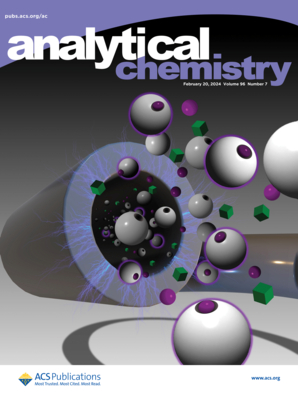Ultrasensitive Quantum Weak Measurement Biochemical Sensor via a Porous Anodic Alumina Nanostructure.
IF 6.7
1区 化学
Q1 CHEMISTRY, ANALYTICAL
引用次数: 0
Abstract
In this paper, an ultrasensitive quantum weak measurement biochemical sensor based on porous anodic alumina (PAA) was first proposed and realized. The PAA film has the advantages of a regular hexagonal arrangement of pores, a high specific surface area, and low cost, which is a significant biosensing platform. By optimizing the structure parameters such as pore size and thickness of the PAA film, the biochemical sensor achieves a refractive index sensitivity of as high as 25 326 nm/RIU with a corresponding resolution of as low as 1.4 × 10-7 RIU. The combination of the PAA film and weak measurement technology amplifies the sensing changes of small phase differences, thus realizing a highly sensitive response to the changes of the sensing medium. The biochemical sensor is capable of detecting biomolecules, such as glucose and proteins, with low detection limits and high specificity. Molecular testing validates that the sensor has a limit of detection as low as 3.9 mg/L for glucose small molecules and 112 pM for bovine serum albumin (BSA) biomacromolecules. The specificity testing validates that the biosensor is capable of specifically recognizing IgG proteins with high sensitivity, and a limit of detection as low as 8.4 ng/mL was achieved. As a result, the proposed PAA-based reflection-type quantum weak measurement biochemical sensor has the advantages of robustness and simplicity of structure, providing a versatile platform for the next generation of high-sensitivity biochemical sensing technology.基于多孔阳极氧化铝纳米结构的超灵敏量子弱测量生化传感器。
本文首次提出并实现了一种基于多孔阳极氧化铝(PAA)的超灵敏量子弱测量生化传感器。PAA薄膜具有气孔六边形排列规则、比表面积高、成本低等优点,是一种重要的生物传感平台。通过优化PAA膜的孔径和厚度等结构参数,该生化传感器的折射率灵敏度高达25 326 nm/RIU,对应的分辨率低至1.4 × 10-7 RIU。PAA薄膜与微弱测量技术相结合,放大了小相位差的传感变化,从而实现了对传感介质变化的高灵敏度响应。该传感器能够检测生物分子,如葡萄糖和蛋白质,检测限低,特异性高。分子测试证实该传感器对葡萄糖小分子的检测限低至3.9 mg/L,对牛血清白蛋白(BSA)生物大分子的检测限低至112 pM。特异性测试表明,该生物传感器具有高灵敏度特异性识别IgG蛋白的能力,检测限低至8.4 ng/mL。因此,基于聚苯胺的反射型量子弱测量生化传感器具有鲁棒性和结构简单的优点,为下一代高灵敏度生化传感技术提供了一个通用的平台。
本文章由计算机程序翻译,如有差异,请以英文原文为准。
求助全文
约1分钟内获得全文
求助全文
来源期刊

Analytical Chemistry
化学-分析化学
CiteScore
12.10
自引率
12.20%
发文量
1949
审稿时长
1.4 months
期刊介绍:
Analytical Chemistry, a peer-reviewed research journal, focuses on disseminating new and original knowledge across all branches of analytical chemistry. Fundamental articles may explore general principles of chemical measurement science and need not directly address existing or potential analytical methodology. They can be entirely theoretical or report experimental results. Contributions may cover various phases of analytical operations, including sampling, bioanalysis, electrochemistry, mass spectrometry, microscale and nanoscale systems, environmental analysis, separations, spectroscopy, chemical reactions and selectivity, instrumentation, imaging, surface analysis, and data processing. Papers discussing known analytical methods should present a significant, original application of the method, a notable improvement, or results on an important analyte.
 求助内容:
求助内容: 应助结果提醒方式:
应助结果提醒方式:


